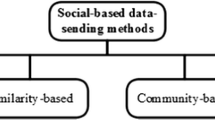Abstract
Opportunistic mobile networks enable mobile devices to exchange data by opportunistic contacts between devices. Since communication is highly impacted by human mobility, the social properties of human beings are exploited to improve the performance of data forwarding. In this paper, we first analyze the threshold configuration of community merging during the process of distributed community discovery. We then introduce a new social-based routing algorithm, called Community Roamer, which identifies those active nodes moving between different clustered communities to create an efficient inter-community forwarding path. Simulations on four real data sets show that the new algorithm has a much lower overhead than the existing algorithms and comparable message delivery ratio.
Access this chapter
Tax calculation will be finalised at checkout
Purchases are for personal use only
Preview
Unable to display preview. Download preview PDF.
Similar content being viewed by others
References
Eagle, N., Pentland, A.: Reality mining: Sensing complex social systems. Personal and Ubiquitous Computing 10(4), 255–268 (2006)
Chaintreau, A., Hui, P., Crowcroft, J., Diot, C., Gass, R., Scott, J.: Impact of human mobility on the design of opportunistic forwarding algorithms. In: Proceedings of the 29th Conference on Information Communications (INFOCOM 2006), pp. 1–13 (2006)
Varvello, M., Voelker, G.M.: Second life: A social network of humans and bots. In: Proceedings of the 20th International Workshop on Network and Operating Systems Support for Digital Audio and Video (NOSSDAV 2010), pp. 9–14 (2010)
Hui, P., Crowcroft, J.: How small labels create big improvements. In: Proceedings of the Fifth IEEE International Conference on Pervasive Computing and Communications Workshops (PERCOMW 2007), pp. 65–70 (2007)
Hui, P., Crowcroft, J., Yoneki, E.: Bubble rap: Social-based forwarding in delay tolerant networks. IEEE Transactions on Mobile Computing 10(11), 1576–1589 (2010)
Bulut, E., Szymanski, B.K.: Exploiting friendship relations for efficient routing in mobile social networks. IEEE Transactions on Parallel and Distributed Systems 23(12), 2254–2265 (2012)
Nguyen, N.P., Dinh, T.N., Tokala, S., Thai, M.T.: Overlapping communities in dynamic networks: Their detection and mobile applications. In: Proceedings of the 17th Annual International Conference on Mobile Computing and Networking (MobiCom 2011), pp. 85–96 (2011)
Mtibaa, A., May, M., Diot, C., Ammar, M.: Peoplerank: Social opportunistic forwarding. In: Proceedings of the 29th Conference on Information Communications (INFOCOM 2010), pp. 111–115 (2010)
Daly, E.M., Haahr, M.: Social network analysis for information flow in disconnected delay-tolerant manets. IEEE Transactions on Mobile Computing 8(5), 606–621 (2009)
Gao, W., Cao, G., Porta, T.L., Han, J.: On exploiting transient social contact patterns for data forwarding in delay-tolerant networks. IEEE Transactions on Mobile Computing 12(1), 151–165 (2013)
Fortunato, S.: Community detection in graphs. Physics Reports 486, 75–174 (2010)
Hui, P., Yoneki, E., Chan, S.Y., Crowcroft, J.: Distributed community detection in delay tolerant networks. In: Proceedings of 2nd ACM/IEEE International Workshop on Mobility in the Evolving Internet Architecture (MobiArch 2007), pp. 1–8 (2007)
Vahdat, A., Becker, D.: Epidemic Routing for Partially-Connected Ad Hoc Networks. Duke University (2000)
Spyropoulos, T., Psounis, K., Raghavendra, C.S.: Spray and wait: an efficient routing scheme for intermittently connected mobile networks. In: Proceedings of the, ACM SIGCOMM Workshop on Delay-Tolerant Networking (WDTN 2005), pp. 252–259 (2005)
Lindgren, A., Doria, A., Schelén, O.: Probabilistic routing in intermittently connected networks. SIGMOBILE Mob. Comput. Commun. Rev. 7(3), 19–20 (2003)
Palla, G., Imre Derenyi, I.F., Vicsek, T.: Uncovering the overlapping community structure of complex networks in nature and society. Nature 435, 814–818 (2005)
Zyba, G., Voelker, G.M., Ioannidis, S., Diot, C.: Dissemination in opportunistic mobile ad-hoc networks: The power of the crowd. In: Proceedings of the 29th Conference on Information Communications (INFOCOM 2011), pp. 1179–1187 (2011)
Pietilänen, A.K., Diot, C.: Dissemination in opportunistic social networks: The role of temporal communities. In: Proceedings of the Thirteenth ACM International Symposium on Mobile Ad Hoc Networking and Computing (MobiHoc 2012), pp. 165–174 (2012)
Clauset, A.: Finding local community structure in networks. Physical Review E (2005)
Newman, M.E.J., Girvan, M.: Finding and evaluating community structure in networks. Physical Review E 69 (2004)
Orlinski, M., Filer, N.: The rise and fall of spatio-temporal clusters in mobile ad hoc networks. Ad Hoc Networks 11(5), 1641–1654 (2013)
Yang, J., Leskovec, J.: Defining and evaluating network communities based on ground-truth. In: Proceedings of the ACM SIGKDD Workshop on Mining Data Semantics (MDS 2012), pp. 1–8 (2012)
Shi, J., Malik, J.: Normalized cuts and image segmentation. IEEE Transcations of Pattern Analysis and Machine Intelligence 22(8), 888–905 (2000)
Keränen, A., Ott, J., Kärkkäinen, T.: The one simulator for dtn protocol evaluation. In: Proceedings of the 2nd International Conference on Simulation Tools and Techniques (Simutools 2009), pp. 1–10 (2009)
Orlinski, M.: http://www.shigs.co.uk/connection-traces-for-the-one-simulator/
Author information
Authors and Affiliations
Editor information
Editors and Affiliations
Rights and permissions
Copyright information
© 2014 Springer International Publishing Switzerland
About this paper
Cite this paper
Zhu, T., Wang, C., Liu, D. (2014). Community Roamer: A Social-Based Routing Algorithm in Opportunistic Mobile Networks. In: Sun, Xh., et al. Algorithms and Architectures for Parallel Processing. ICA3PP 2014. Lecture Notes in Computer Science, vol 8630. Springer, Cham. https://doi.org/10.1007/978-3-319-11197-1_61
Download citation
DOI: https://doi.org/10.1007/978-3-319-11197-1_61
Publisher Name: Springer, Cham
Print ISBN: 978-3-319-11196-4
Online ISBN: 978-3-319-11197-1
eBook Packages: Computer ScienceComputer Science (R0)




